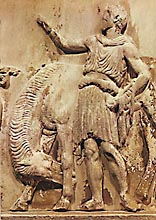The subject of the frieze is the procession of the Great Panathenaea, with the newly-made peplos of the goddess Athena being brought up to the Parthenon. The procession divides into two groups that start off from the south-west corner of the temple and meet again in the middle of the east front, at the scene with the peplos. Along the west front there are riders beside their mounts. At the north-west corner the procession is starting off, to be seen in full swing along the long sides of the cella. Figures of horsemen, chariot-racers, and apobatai appear. We also see men leading sacrificial oxen. And there are other figures, carrying baskets, waterjugs, and branches: these are the kanephoroi, hydrophoroi and thallophoroi respectively. On the east front, the peplos is being presented to the archon basileus: this scene is framed by the Olympian gods, in two separate groups. |
 |





